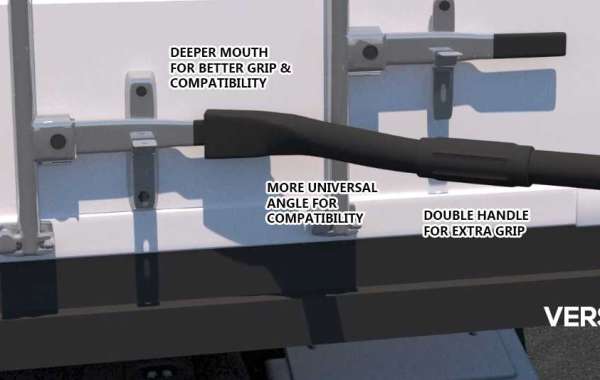Railroads are a critical component of the global transportation network, facilitating the efficient movement of both goods and passengers across vast distances. However, rail transport comes with inherent safety challenges, including high speeds, heavy cargo loads, and variable weather conditions. To address these risks, a wide array of Railroad Safety Equipment is employed to ensure the safety of trains, passengers, cargo, and railway workers. This article explores the essential safety systems and tools that contribute to safe rail operations.

Trackside Safety Systems
Maintaining safety along the tracks is crucial to preventing accidents such as derailments and collisions. Trackside safety systems are designed to monitor track conditions, control train movements, and alert operators to potential hazards.
- Signals and Control Systems: Signals regulate train movements along tracks. Modern systems, like Positive Train Control (PTC), use GPS and onboard computers to automatically prevent train collisions, derailments due to excessive speeds, and unauthorized track use.
- Derailers: These mechanical devices can be installed on tracks to intentionally derail a train if it enters an unauthorized area or approaches a work zone, preventing more severe accidents.
- Hot Box Detectors: These devices monitor the temperature of train wheel bearings. If a bearing overheats, known as a "hot box," it can cause wheel failure, potentially leading to derailments. Early detection helps prevent this risk.
- Weigh-in-Motion (WIM) Systems: These systems measure the weight of trains as they pass over the track, ensuring loads are properly balanced. Overloading can damage tracks and cause derailments, making these systems essential.
Onboard Safety Equipment
Safety systems onboard trains are designed to protect passengers, cargo, and the crew by controlling train operations and responding quickly to emergencies.
- Automatic Train Control (ATC): This system adjusts train speed based on signals and track conditions. It helps ensure that trains operate within safe limits, automatically slowing down or stopping the train if needed.
- Brake Systems: Modern air brake systems provide smooth, controlled braking. In emergencies, advanced systems can stop a train quickly while maintaining stability.
- Dead Man’s Switch: A vital safety feature, this switch requires constant engagement by the operator. If the operator is incapacitated, the system automatically stops the train.
- Event Recorders (Black Boxes): Similar to airplane black boxes, these devices record important data such as speed, braking, and throttle usage. In the event of an accident, the data helps investigators understand what occurred.
Ergonomic Solutions
In both rail operations and maintenance, repetitive motions and physical strain can lead to long-term injuries. Ergonomic solutions minimize these risks, improving worker safety and comfort.
- Lifting Aids: Tools like hoists, conveyors, and lift tables reduce the need for manual lifting, preventing musculoskeletal injuries.
- Ergonomic Tools: Designed with worker comfort in mind, these tools help minimize repetitive strain injuries, ensuring workers can perform tasks efficiently and safely.
Shipping Container Leverage Tool for Opening and Closing Shipping Container Doors
Opening and closing shipping container doors, particularly in harsh weather, can be a physically demanding task for railway workers. The OpnBar shipping container leverage tool simplifies this process, providing the leverage needed to handle container doors safely. It also doubles as a tire thumper and a 5th wheel pull hook, making it a versatile safety tool for rail and intermodal transport operations.

Rail Worker Protection Equipment
Railway workers face various risks while maintaining tracks or operating trains. Ensuring they have access to the right protective equipment is critical to keeping them safe.
- High-Visibility Clothing: Railway workers often operate in low-visibility environments. High-visibility vests, jackets, and pants ensure that workers are easily seen by train operators and other machinery operators, reducing the risk of accidents.
- Portable Derailers and Flags: Workers setting up temporary work zones often use portable derailers to prevent trains from entering. Signal flags further enhance visibility to approaching trains.
- Track Inspection Vehicles: These specialized vehicles allow workers to inspect tracks without entering hazardous areas. Equipped with sensors and cameras, they detect track defects, such as cracks or misalignments, which could lead to derailments.
- Personal Protective Equipment (PPE): Workers wear PPE such as hard hats, steel-toed boots, and gloves to protect against the physical hazards of rail operations. In hazardous environments, respiratory protection may also be required.
Level Crossing Protection
Level crossings, where roads intersect railways, are some of the most hazardous points in the rail network. Level crossing safety equipment ensures that vehicles and pedestrians are protected from oncoming trains.
- Automatic Barriers and Gates: These barriers close when a train is approaching, preventing cars and pedestrians from crossing. They are often accompanied by flashing lights and alarms.
- Warning Systems: Audible and visual warnings alert drivers and pedestrians of an oncoming train, giving them enough time to clear the crossing.
- Obstacle Detection Systems: Some level crossings are equipped with sensors that detect vehicles or objects stuck on the tracks. The system alerts the train operator to stop in time to avoid a collision.
Fire Detection and Suppression Systems
Fire safety is a critical concern in rail operations, especially on passenger trains and those carrying hazardous cargo. Fire detection and suppression systems are key to preventing catastrophic fires.
- Smoke Detectors and Fire Alarms: These are installed on passenger trains and in freight cars carrying sensitive materials to detect fires early and alert the crew.
- Fire Suppression Systems: Fire extinguishers and automated systems such as foam or inert gas extinguishers are used to control fires and prevent them from spreading.
Hazardous Materials (HazMat) Safety
Railways often transport hazardous materials that pose significant risks to workers, the public, and the environment. HazMat safety equipment ensures that these materials are handled and transported safely.
- Spill Containment Systems: Freight cars carrying hazardous liquids often have double-walled containment systems to prevent leaks. In case of spills, containment kits are strategically placed along the route to mitigate the effects.
- Vapor Detection Systems: These systems detect dangerous gas leaks in freight cars carrying hazardous materials, alerting the crew and allowing for immediate action.
- Emergency Response Kits: HazMat kits with absorbent materials, neutralizers, and protective gear are stationed along routes to ensure rapid responses to spills or accidents.

Conclusion
Railroad safety is a complex and vital aspect of the transportation industry. From trackside monitoring systems to onboard safety devices and worker protection equipment, the variety of safety measures in place ensures that rail operations are safe, efficient, and reliable. As technology advances, the rail industry continues to adopt smarter and more effective solutions for accident prevention and risk management. By prioritizing safety equipment and practices, rail operators protect not only their assets but also the lives of workers, passengers, and the public.
WEBSITE: https://www.shippingcontainertool.com/railroad-safety-equipment/
ADDRESS: 10053 Whittwood Dr,
Suite 11284 Whittier, CA 90603
USA | 657.6.OPNBAR
(657-667-6227)
VIDEO:








